Abstract
Armstrong, D. (The Children's Hospital of Philadelphia, Philadelphia, Pa.), G. Henle, N. L. Somerson, and L. Hayflick. Cytopathogenic mycoplasmas associated with two human tumors. I. Isolation and biological aspects. J. Bacteriol. 90:418–424. 1965.—Mycoplasmas were isolated from cell cultures of two benign human tumors. The first isolate contained two mycoplasmas, one a well-known human species (Mycoplasma hominis type I) and frequent tissue culture contaminant, and the other a recently reported new type. The second isolate was a mycoplasma of the newly described type. The mycoplasmas could be reisolated, after one or more passages through tissue culture, from extracts of the original tumor tissue. The relationship of the organisms to the neoplasms remains obscure. Both isolates produce cytopathic effect (CPE) and acidification of medium in a variety of tissue cultures. The CPE may be diminished, but not abolished, by increasing concentrations of arginine in the tissue culture media. Infection of various tissue cultures with the mycoplasmas did not result in interference to super-infection with vesicular stomatitis virus.
Full text
PDF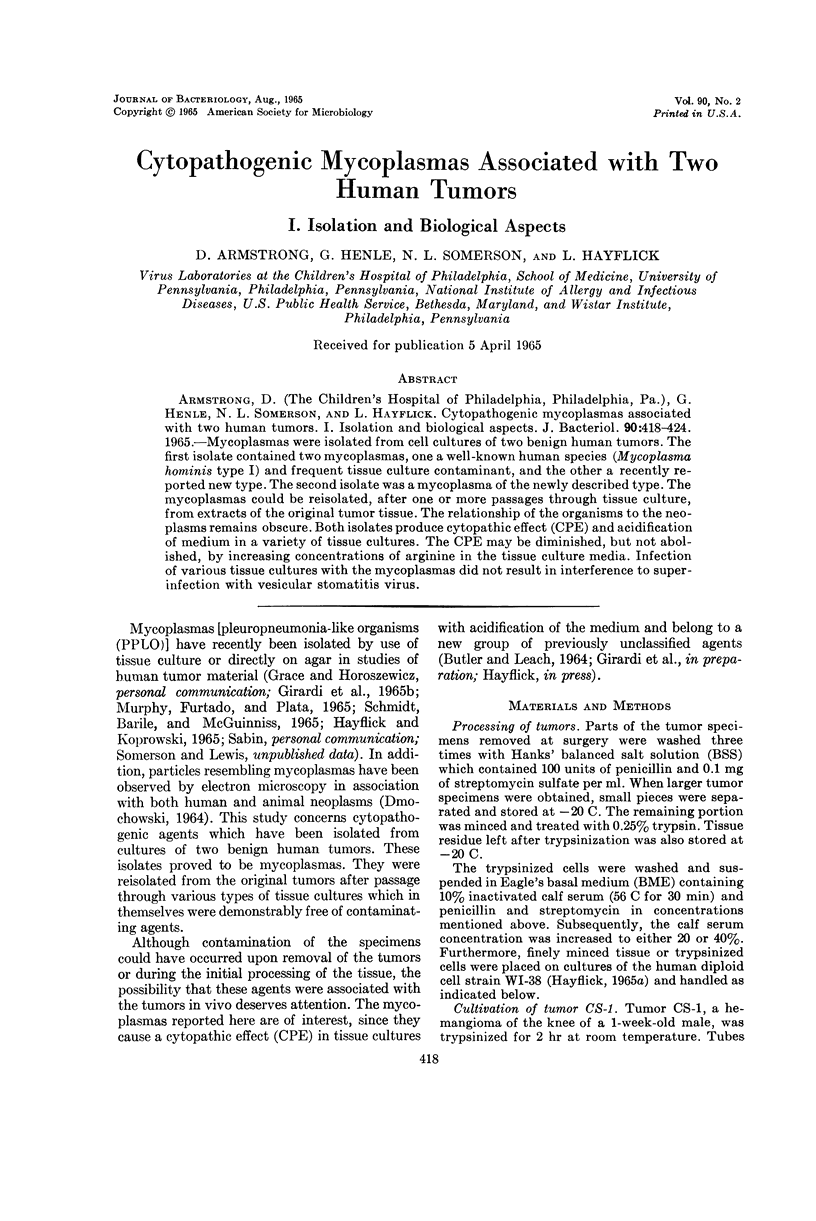
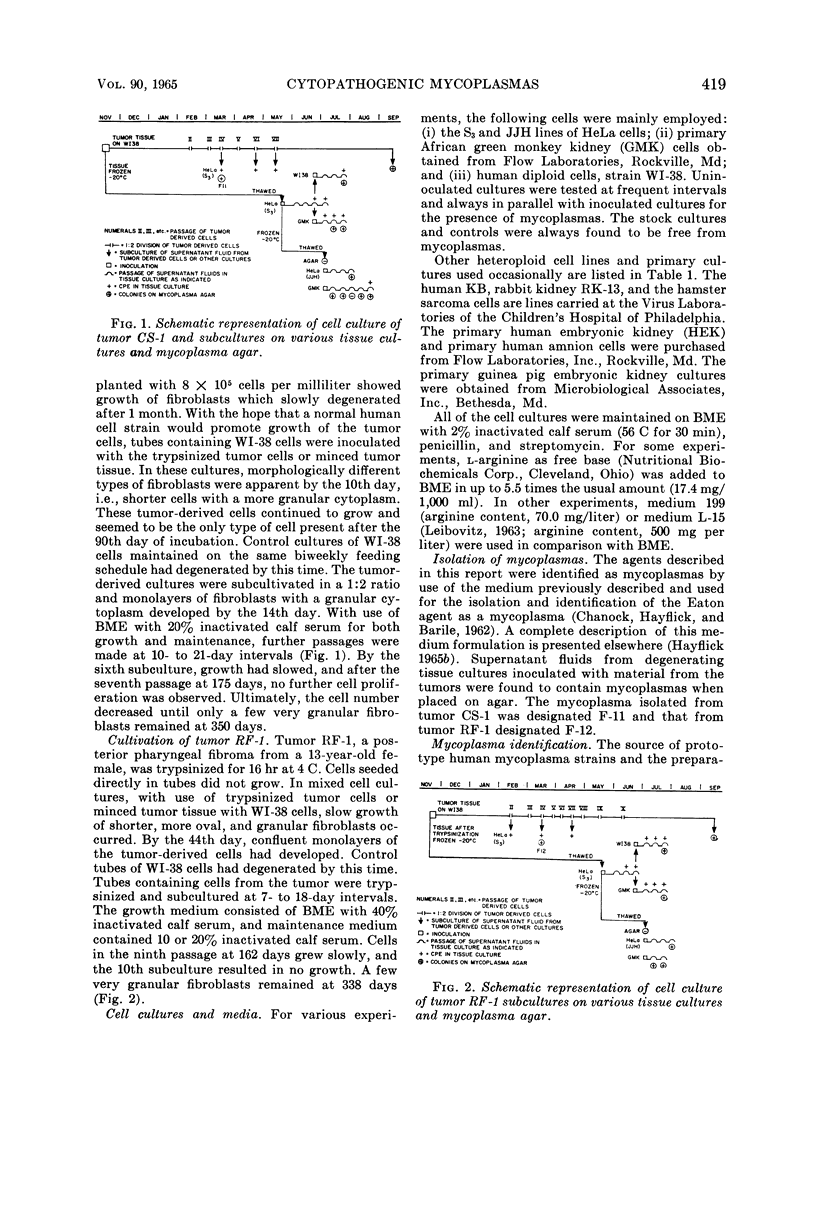
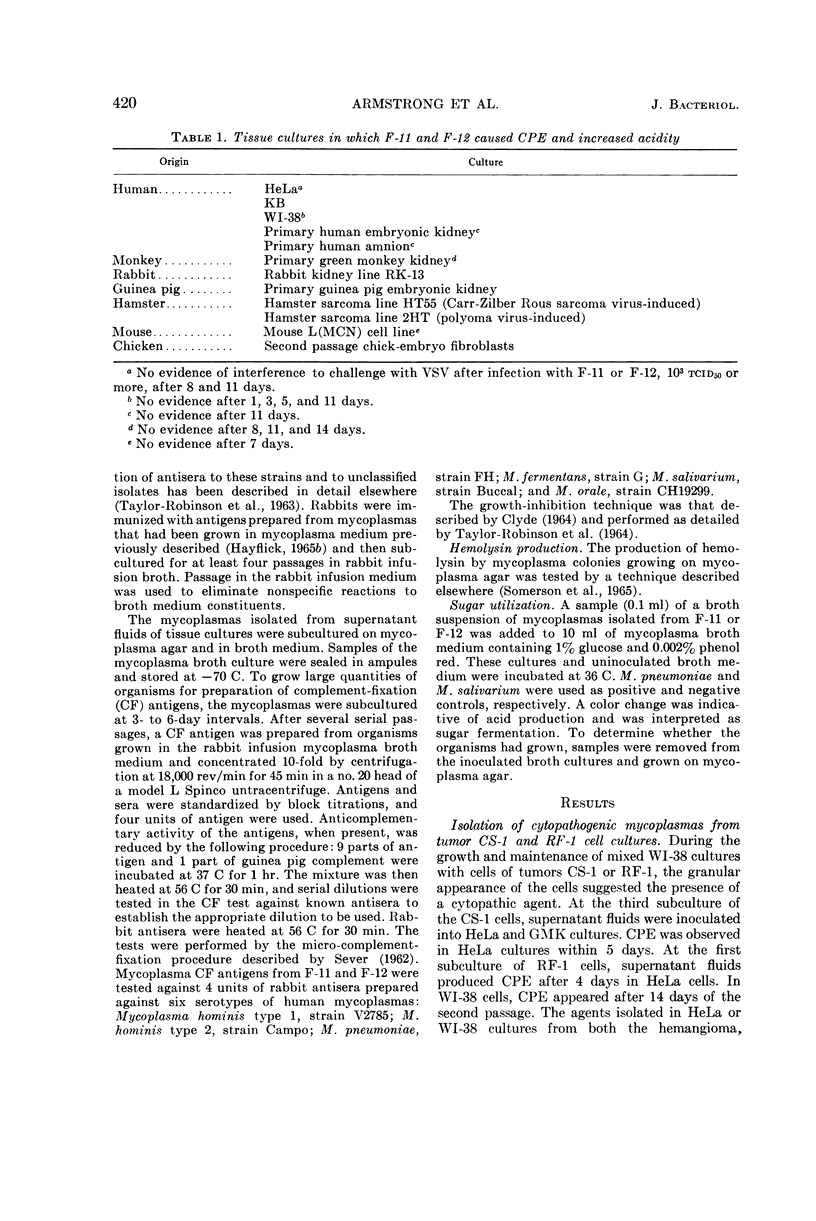
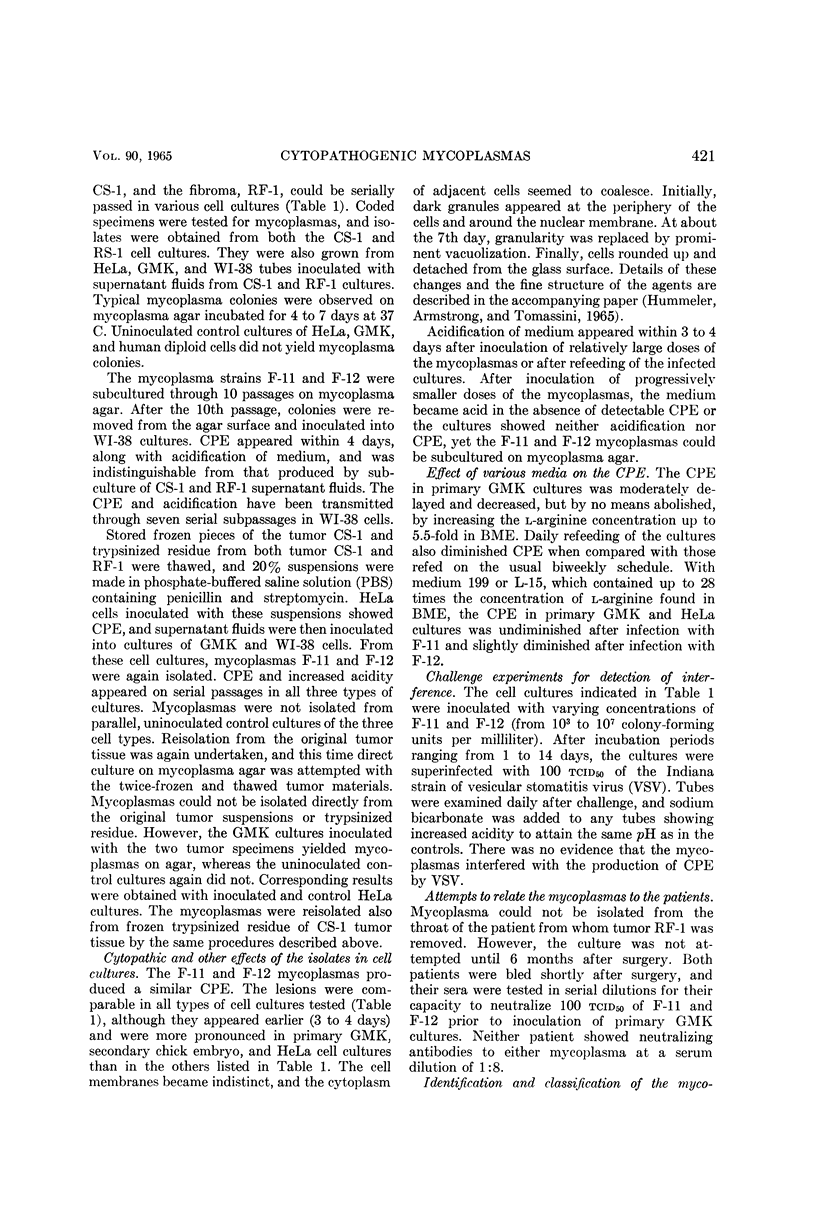
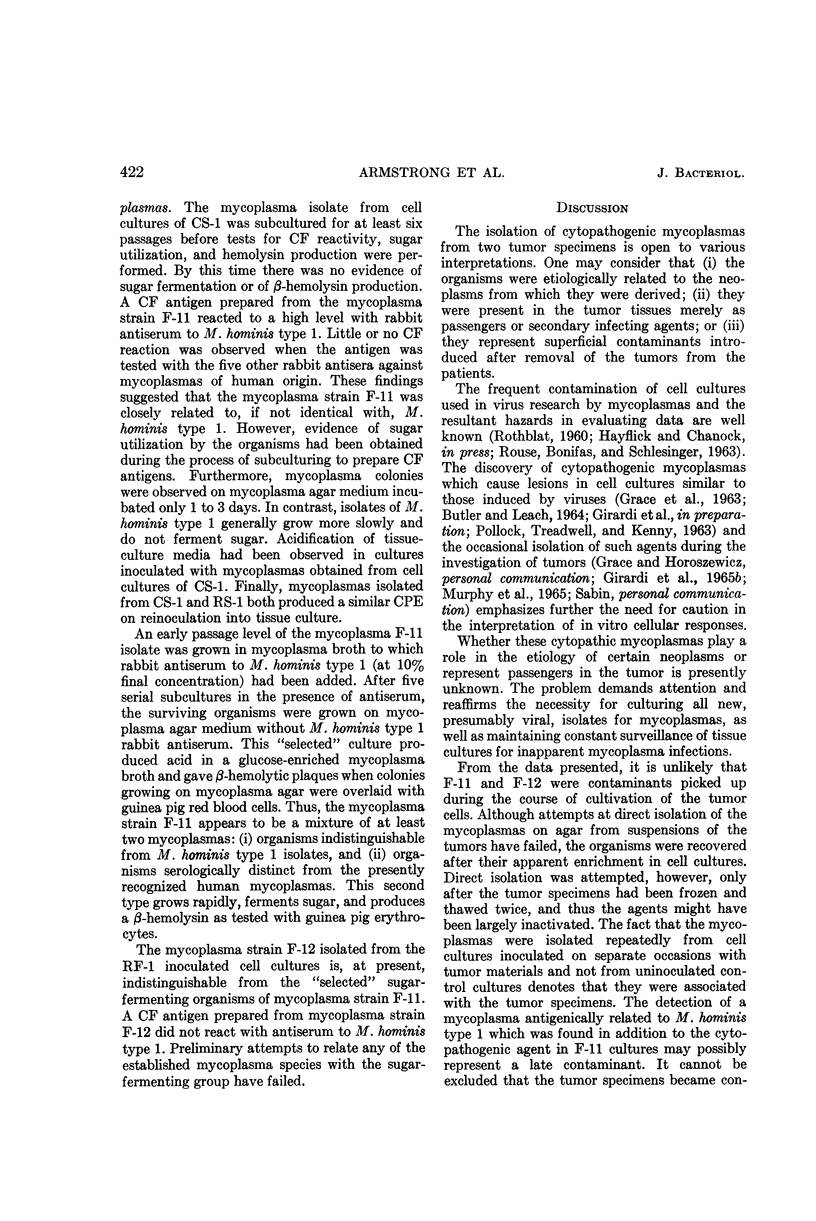
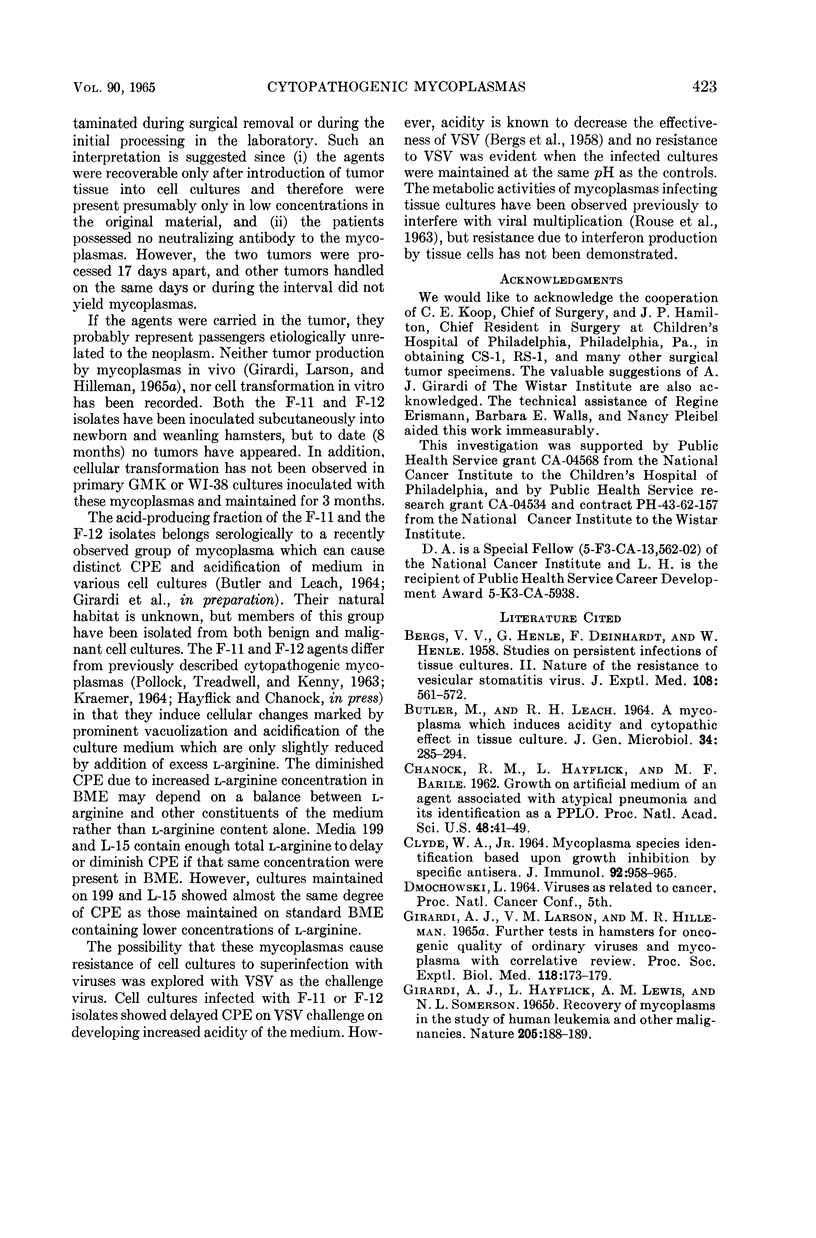
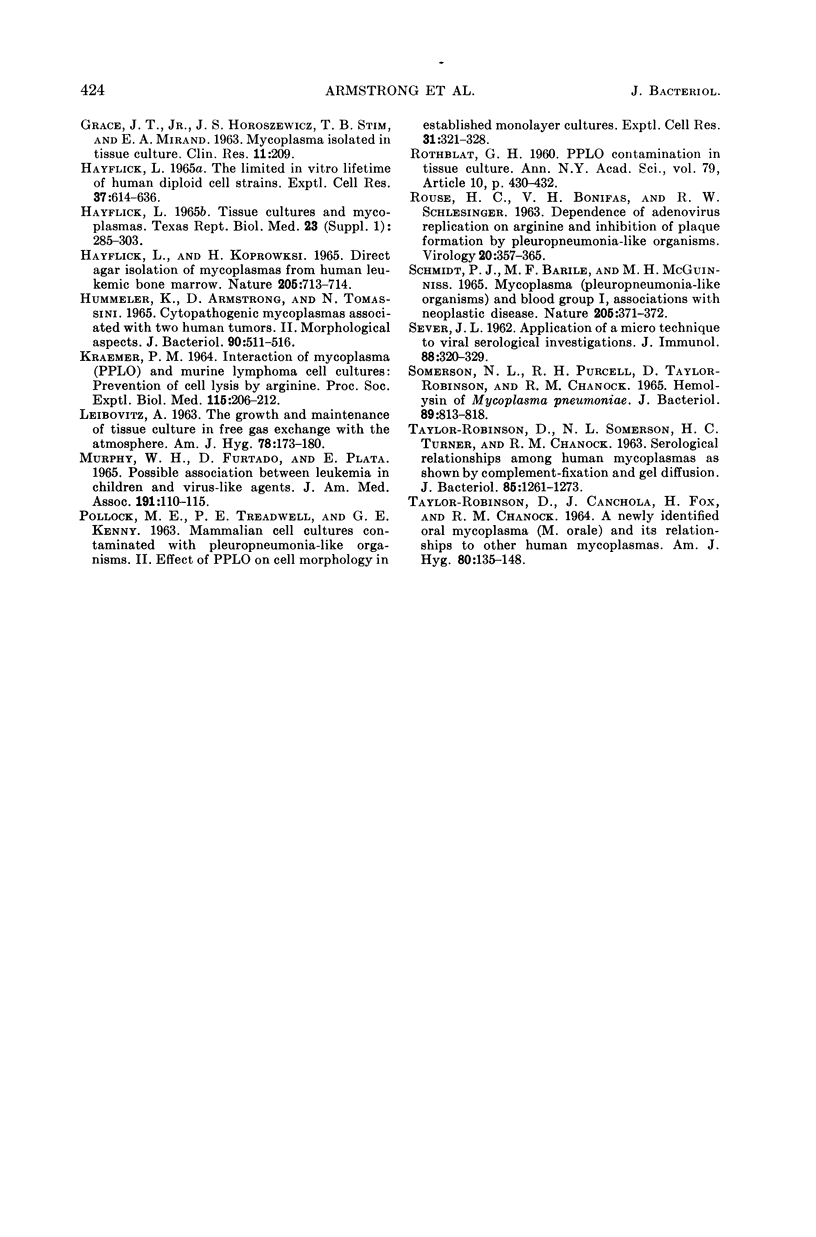
Selected References
These references are in PubMed. This may not be the complete list of references from this article.
- BERGS V. V., HENLE G., DEINHARDT F., HENLE W. Studies on persistent infections of tissue cultures. II. Nature of the resistance to vesicular stomatitis virus. J Exp Med. 1958 Oct 1;108(4):561–572. doi: 10.1084/jem.108.4.561. [DOI] [PMC free article] [PubMed] [Google Scholar]
- BUTLER M., LEACH R. H. A MYCOPLASMA WHICH INDUCES ACIDITY AND CYTOPATHIC EFFECT IN TISSUE CULTURE. J Gen Microbiol. 1964 Feb;34:285–294. doi: 10.1099/00221287-34-2-285. [DOI] [PubMed] [Google Scholar]
- CHANOCK R. M., HAYFLICK L., BARILE M. F. Growth on artificial medium of an agent associated with atypical pneumonia and its identification as a PPLO. Proc Natl Acad Sci U S A. 1962 Jan 15;48:41–49. doi: 10.1073/pnas.48.1.41. [DOI] [PMC free article] [PubMed] [Google Scholar]
- CLYDE W. A., Jr MYCOPLASMA SPECIES IDENTIFICATION BASED UPON GROWTH INHIBITION BY SPECIFIC ANTISERA. J Immunol. 1964 Jun;92:958–965. [PubMed] [Google Scholar]
- GIRARDI A. J., HAYFLICK L., LEWIS A. M., SOMERSON N. L. RECOVERY OF MYCOPLASMAS IN THE STUDY OF HUMAN LEUKAEMIA AND OTHER MALIGNANCIES. Nature. 1965 Jan 9;205:188–189. doi: 10.1038/205188a0. [DOI] [PubMed] [Google Scholar]
- GIRARDI A. J., LARSON V. M., HILLEMAN M. R. FURTHER TESTS IN HAMSTERS FOR ONCOGENIC QUALITY OF ORDINARY VIRUSES AND MYCOPLASMA, WITH CORRELATIVE REVIEW. Proc Soc Exp Biol Med. 1965 Jan;118:173–179. doi: 10.3181/00379727-118-29789. [DOI] [PubMed] [Google Scholar]
- HAYFLICK L., KOPROWSKI H. DIRECT AGAR ISOLATION OF MYCOPLASMAS FROM HUMAN LEUKAEMIC BONE MARROW. Nature. 1965 Feb 13;205:713–714. doi: 10.1038/205713b0. [DOI] [PubMed] [Google Scholar]
- HAYFLICK L. THE LIMITED IN VITRO LIFETIME OF HUMAN DIPLOID CELL STRAINS. Exp Cell Res. 1965 Mar;37:614–636. doi: 10.1016/0014-4827(65)90211-9. [DOI] [PubMed] [Google Scholar]
- HUMMELER K., ARMSTRONG D., TOMASSINI N. CYTOPATHOGENIC MYCOPLASMAS ASSOCIATED WITH TWO HUMAN TUMORS. II. MORPHOLOGICAL ASPECTS. J Bacteriol. 1965 Aug;90:511–516. doi: 10.1128/jb.90.2.511-516.1965. [DOI] [PMC free article] [PubMed] [Google Scholar]
- KRAEMER P. M. INTERACTION OF MYCOPLASMA (PPLO) AND MURINE LYMPHOMA CELL CULTURES: PREVENTION OF CELL LYSIS BY ARGININE. Proc Soc Exp Biol Med. 1964 Jan;115:206–212. doi: 10.3181/00379727-115-28871. [DOI] [PubMed] [Google Scholar]
- LEIBOVITZ A. THE GROWTH AND MAINTENANCE OF TISSUE-CELL CULTURES IN FREE GAS EXCHANGE WITH THE ATMOSPHERE. Am J Hyg. 1963 Sep;78:173–180. doi: 10.1093/oxfordjournals.aje.a120336. [DOI] [PubMed] [Google Scholar]
- MURPHY W. H., FURTADO D., PLATA E. POSSIBLE ASSOCIATION BETWEEN LEUKEMIA IN CHILDREN AND VIRUS-LIKE AGENTS. JAMA. 1965 Jan 11;191:110–115. doi: 10.1001/jama.1965.03080020038012. [DOI] [PubMed] [Google Scholar]
- POLLOCK M. E., TREADWELL P. E., KENNY G. E. MAMMALIAN CELL CULTURES CONTAMINATED WITH PLEUROPNEUMONIA-LIKE ORGANISMS. II. EFFECT OF PPLO ON CELL MORPHOLOGY IN ESTABLISHED MONOLAYER CULTURES. Exp Cell Res. 1963 Aug;31:321–328. doi: 10.1016/0014-4827(63)90009-0. [DOI] [PubMed] [Google Scholar]
- ROTHBLAT G. H. PPLO contamination in tissue cultures. Ann N Y Acad Sci. 1960 Jan 15;79:430–432. doi: 10.1111/j.1749-6632.1960.tb42708.x. [DOI] [PubMed] [Google Scholar]
- SCHMIDT P. J., BARILE M. F., MCGINNISS M. H. MYCOPLASMA (PLEUROPNEUMONIA-LIKE ORGANISMS) AND BLOOD GROUP I; ASSOCIATIONS WITH NEOPLASTIC DISEASE. Nature. 1965 Jan 23;205:371–372. doi: 10.1038/205371a0. [DOI] [PubMed] [Google Scholar]
- SEVER J. L. Application of a microtechnique to viral serological investigations. J Immunol. 1962 Mar;88:320–329. [PubMed] [Google Scholar]
- SOMERSON N. L., PURCELL R. H., TAYLOR-ROBINSON D., CHANOCK R. M. HEMOLYSIN OF MYCOPLASMA PNEUMONIAE. J Bacteriol. 1965 Mar;89:813–818. doi: 10.1128/jb.89.3.813-818.1965. [DOI] [PMC free article] [PubMed] [Google Scholar]
- TAYLOR-ROBINSON D., CANCHOLA J., FOX H., CHANOCK R. M. A NEWLY IDENTIFIED ORAL MYCOPLASMA (M. ORALE) AND ITS RELATIONSHIP TO OTHER HUMAN MYCOPLASMAS. Am J Hyg. 1964 Jul;80:135–148. doi: 10.1093/oxfordjournals.aje.a120454. [DOI] [PubMed] [Google Scholar]
- TAYLOR-ROBINSON D., SOMERSON N. L., TURNER H. C., CHANOCK R. M. SEROLOGICAL RELATIONSHIPS AMONG HUMAN MYCOPLASMAS AS SHOWN BY COMPLEMENT-FIXATION AND GEL DIFFUSION. J Bacteriol. 1963 Jun;85:1261–1273. doi: 10.1128/jb.85.6.1261-1273.1963. [DOI] [PMC free article] [PubMed] [Google Scholar]


